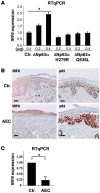A regulatory feedback loop involving p63 and IRF6 links the pathogenesis of 2 genetically different human ectodermal dysplasias
- PMID: 20424325
- PMCID: PMC2860936
- DOI: 10.1172/JCI40267
A regulatory feedback loop involving p63 and IRF6 links the pathogenesis of 2 genetically different human ectodermal dysplasias
Abstract
The human congenital syndromes ectrodactyly ectodermal dysplasia-cleft lip/palate syndrome, ankyloblepharon ectodermal dysplasia clefting, and split-hand/foot malformation are all characterized by ectodermal dysplasia, limb malformations, and cleft lip/palate. These phenotypic features are a result of an imbalance between the proliferation and differentiation of precursor cells during development of ectoderm-derived structures. Mutations in the p63 and interferon regulatory factor 6 (IRF6) genes have been found in human patients with these syndromes, consistent with phenotypes. Here, we used human and mouse primary keratinocytes and mouse models to investigate the role of p63 and IRF6 in proliferation and differentiation. We report that the DeltaNp63 isoform of p63 activated transcription of IRF6, and this, in turn, induced proteasome-mediated DeltaNp63 degradation. This feedback regulatory loop allowed keratinocytes to exit the cell cycle, thereby limiting their ability to proliferate. Importantly, mutations in either p63 or IRF6 resulted in disruption of this regulatory loop: p63 mutations causing ectodermal dysplasias were unable to activate IRF6 transcription, and mice with mutated or null p63 showed reduced Irf6 expression in their palate and ectoderm. These results identify what we believe to be a novel mechanism that regulates the proliferation-differentiation balance of keratinocytes essential for palate fusion and skin differentiation and links the pathogenesis of 2 genetically different groups of ectodermal dysplasia syndromes into a common molecular pathway.
Figures





Comment in
-
p63 and IRF6: brothers in arms against cleft palate.J Clin Invest. 2010 May;120(5):1386-9. doi: 10.1172/JCI42821. Epub 2010 Apr 26. J Clin Invest. 2010. PMID: 20424318 Free PMC article.
References
Publication types
MeSH terms
Substances
Grants and funding
LinkOut - more resources
Full Text Sources
Other Literature Sources
Molecular Biology Databases

